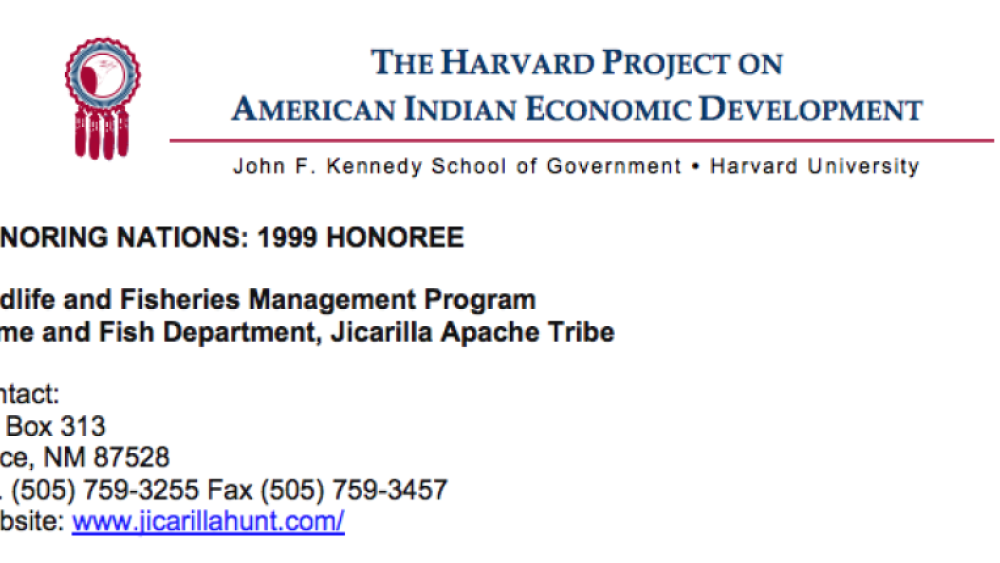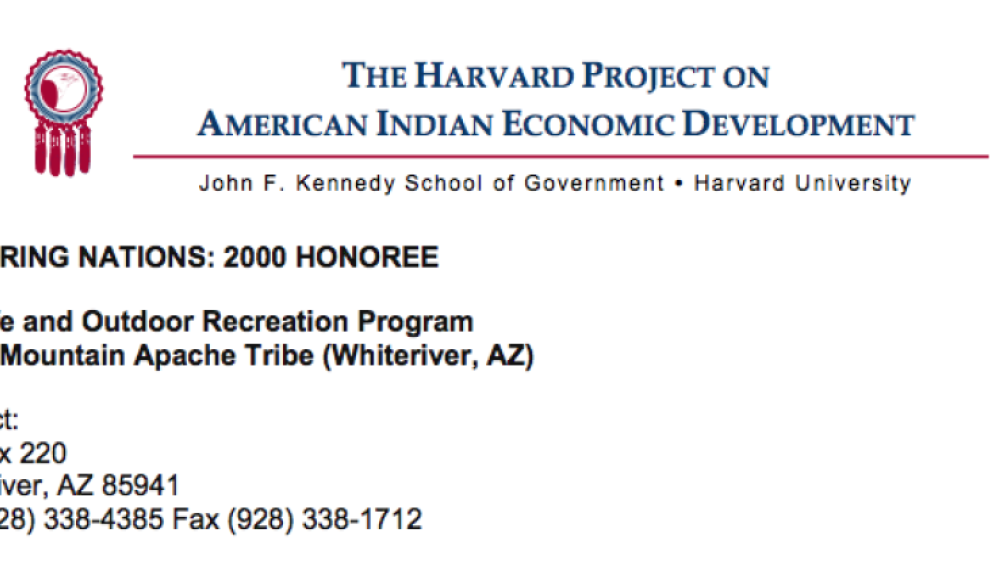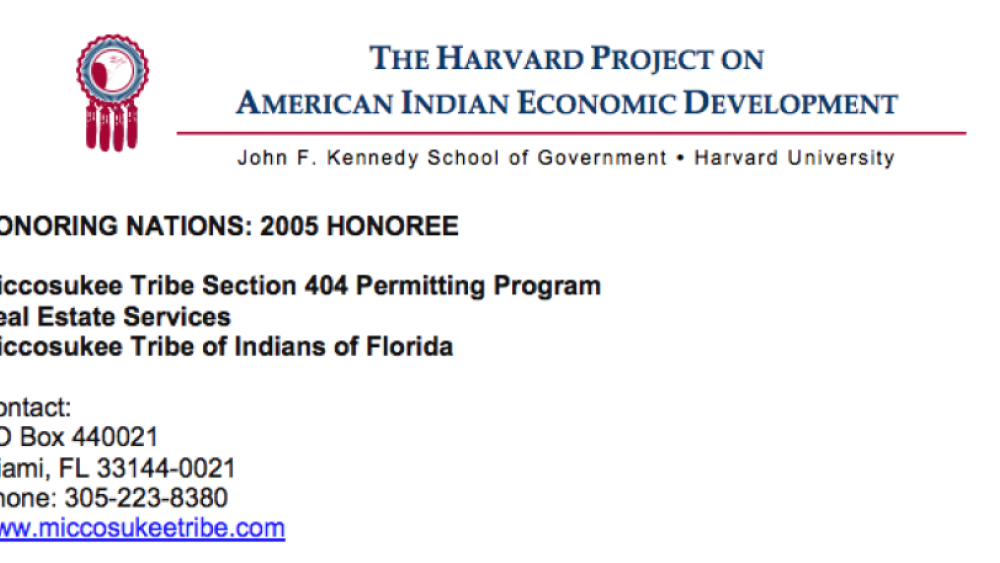Miccosukee Tribe Land Resources Manager Steve Terry and Fish and Wildlife Director Rory Feeney present an overview of the Miccosukee Tribe Section 404 Permitting Program to the Honoring Nations Board of Governors in conjunction with the 2005 Honoring Nations Awards.
Additional Information
Feeney, Rory, and Steve Terry. "Miccosukee Tribe Section 404 Permitting Program." Honoring Nations Awards event. Harvard Project on American Indian Economic Development, John F. Kennedy School of Government, Harvard University. Tulsa, Oklahoma. November 1, 2005. Presentation.
Transcript
Steve Terry:
"First I'd like to thank the board of governors for letting us come up and give our presentation and for considering our program. Chairman Cypress of the Miccosukee Tribe regrets that he cannot be here today but he's still down in Florida coordinating the relief effort to the tribe due to the recent hurricane that we had, Hurricane Wilma.
I'd like to give a little history about the Miccosukee Tribe. The Miccosukee Tribe has always been a separate tribe from the Seminole Tribe. If you read the war accounts, the Seminole Indian wars in Florida, you always see that they refer to the Miccosukee and Seminole war chiefs. The Miccosukees ended up in the Everglades from their homelands in north Florida and south Georgia as a result of the Seminole Indian wars and to escape the Indian removal policy of the United States government. The State of Florida created a 5,000-acre Indian reservation down in the mainland portion of Monroe County in 1917, then in 1935 when they started talking about forming Everglades National Park, promptly gave that reservation as part of the park. The state then created a 110,000-acre reservation in Broward County, but did not consult with the tribe. So needless to say, no tribal members ever moved up to Broward County, they stayed on the old state Indian reservation down in Monroe County. They stayed there until the late 1940s when Monroe County Sheriff's deputies and Everglades Park rangers forced the tribe from the park. The tribe relocated to Tamiami Trail where they reside today. So they used to live up here in north Florida and south Georgia, slowly working their way down the State of Florida through the result of the Indian wars and ended up down here in Monroe County where the Indian reservation was and actually had to relocate right about in there as a result of the park rangers forcing them out. And you can see that a little bit better in this slide.
The reason why I wanted to bring that up is has to do with what we're talking about today is our Section 404 general permit. What a 404 permit is a permit that you get from the U.S. Army Corps of Engineers to place fill-in wetlands on federal land. What a general permit is, that's a permit that the Corps issues to an entity. It follows the parameters agreed upon between the entity and the U.S. Army Corps of Engineers. It allows an entity to place fill-in wetlands with much less time involved, but normally the general permit is still administered by the Corps of Engineers. Mitigation is part of the general permit process. Mitigation is where you make up for the wetlands that you destroyed by filling them by either creating new wetlands or enhancing wetlands. The entity is responsible for following the terms of the general permit. The reason why we had to have a general permit? Tribal housing pads increased in size to accommodate larger homes. 404 permits were taking six months to several years to be approved by the Corps of Engineers. More fill requests were being submitted on a monthly basis into our offices and tribal members were wanting additional fill to increase their house pad and improve their quality of life. They wanted to build a garden, they wanted to have a yard for their children to play in, they wanted to be able to put a chickee up in their backyard, which is the traditional home of the Miccosukees made out of cypress poles and palm fronds. So this is what a typical residential pad used to look like on the left. If you'll see on the right, we've actually increased the size of that pad tremendously. This is what the old style of home is that we used to build on the reservation and now we build this type of a house that's on the reservation, thus requiring the need for much larger pad.
The contents of our general permit: well, we had a permit process in place before applying for the general permit from the Corps of Engineers. Because of this the Corps of Engineers actually allowed the tribe the responsibility to administer and enforce the permit and to the best of my knowledge we're the first tribe that's ever received a general permit from the Corps of Engineers. The terms allow the tribe to issue 404 permits to tribal members in a specific area and for a limited amount of fill. The tribal members are responsible for mitigation and implementation of permit terms. The Real Estate Services Department administers the permit and the Water Resources Department enforces the permit.
So how does our permitting process work? Well, first and foremost the tribal constitution gives the tribe the authority to issue permits. So a tribal member would come into our office and request fill-in wetlands for their property to Real Estate Services. My office would go out, we'd measure property boundaries, we'd stake out a fill area, we'd submit a site drawing, we'd draft the permit and we'd give that to the tribe's business council for their approval. Once the business council approved the permits, we would issue them to the tribal members and we'd also catalogue those so we could do a quarterly update to the Corps of Engineers on the amount of permits that we issued. The tribal member would come in and they would pay mitigation costs, they would acquire and they would also install silt screen.
Rory Feeney:
"My name is Rory Feeney from the Miccosukee Water Resources Office. Part of the Water Resources Department's responsibilities is to monitor and enforce best management practices, or BMPs, of the permit. We meet with the contractor. If we can't meet with the contractor, we will at least phone call them and make sure that he understands the conditions of the permit. Our office will go out and inspect the silt screen or turbidity barriers -- I'll explain what that is in a moment -- and make sure that the silt screen is installed at the right location and in the right way. After the inspection is included, an approval or disapproval will be sent to the homeowner. If it's approved and only once it's approved, the tribal member may then place fill in wetlands or fill on fill. During the construction activity the Water Resources Office continues to monitor the fill activity to make sure that it's in compliance with the permit boundary. And the tribe's law and order code grants jurisdiction to enforce these permit terms. So that's what gives us the structure and foundation to go out and enforce these things.
This is a copy of a typical permit that goes out to the homeowner. You can't really read it, it's small print, but what is on the first page is the cost of mitigation and where to pay that mitigation and the second page shows you step by step what the conditions of the permit are, how much the mitigation is going to cost, that the trash must be cleaned out of the house around the construction area before the fill is done, and that silt screen needs to be installed. This is a typical schematic of a house out there with detailing what the boundaries are and where the silt screen needs to be installed. This is a handout that is also included in the permit package that shows you step by step how to install it and the correct way and incorrect way to install it with pictures on each side showing such. We also include an erosion control handout, why it's important to control the slopes of your house pad with sod and seed. This is that silt screen, a close up of the silt screen that I was telling you about, turbidity monitor. What this does is it prevents silt from getting into the environment and impacting the local flora and fauna. There's another shot. And here's the sod and seed working in tandem with the silt screen there to decrease and minimize impacts onto the environment.
The mitigation Steve was mentioning takes place on tribal land, one-to-one ratio. For one acre of land that's filled, one acre of natural environment is enhanced. By that I mean we cut down, we contract a company to cut down melaleuca trees that have grown in abundance in south Florida. This is pretty much a mono culture of melaleuca trees. They overcrowd natural vegetation and it can smother out the lower vegetation on the bottom. We cut that down and restore it back to what once was...what this should look like is a saw grass, saw palmetto and hardwood ecosystem with cypress and other vegetation."
Steve Terry:
"The benefits of this permitting process: first and foremost it allows the tribe to exercise sovereignty over its own lands and its members. The quality of life for tribal members has improved considerably. Section 106 of the Clean Water Act is being met and our permit process is much faster, usually about one month when before it would take anywhere from six months to a couple of years to get a permit. The Corps of Engineers and EPA [Environmental Protection Agency] now have much less paperwork and less workload. And the government-to-government interaction improved substantially so we no longer end up having to fight the Corps of Engineers like we used to do in the past. And that concludes our presentation."
Amy Besaw:
"Questions from the board?"
Duane Champagne:
"Well, I'd like to congratulate you on the program. I'd like to know your relationship to the tribal government. This is an authority within the constitution and is that a method that has worked very well for this kind of permitting process and how much autonomy do they give you?"
Steve Terry:
"Well, it works very well for us and it was part of the constitution of the tribe that allowed the tribe to manage their own lands. So we used that section from the constitution to start with this. And every permit that we have goes before the tribe's business council and they approve the permit themselves. Now they can either approve a permit, disapprove a permit or tell us to go back and get more information and they have done all three things to us. So it works very well for us this way. And the thing I need to emphasize on this, we're bringing this up as being like just for fill-in wetlands. We don't do just fill-in wetlands. We do all kinds of permits from our office. We do fill-on-fill permits, we do fill agreements with tribal members, we have right away agreements, if they want to put in a driveway, put up a fence, put up a little shop that they want to do, they come to our office and get a permit for that and we go to the business council for their approval first."
Heather Kendall-Miller:
"One of the things that I was intrigued by, obviously what you've achieved is very significant in taking over such a major permitting program from the Corps of Engineers. And we're all...I come from Alaska and stuff and so one of the things that I was impressed by is the fact that the Everglades as far as I know is very sensitive environmentally, and I really expected that your tribe would have had some difficulty dealing with for instance environmental proponents or non-members of your community that would have concerns about the tribe issuing its own permits. Can you explain how it is that somehow you bypassed that kind of controversy?"
Steve Terry:
"When we applied for this general permit, the Corps of Engineers had to put it out for public comments and they put it out there for public comment and we issue drawings that showed where -- if we were going to fill all the areas that we could between all the homes and go back for a specific length that we were doing that -- it would cover about 54 acres of wetlands out on the tribe. And that went out for public comment. The Corps of Engineers did not receive one comment from anybody on this permit application and the only reason why I think that happened is because the Miccosukee Tribe has always been at the forefront of Everglades restoration. We gave the board a copy of our water quality standards and we had some back in the back and obviously Rory and I didn't bring near enough because they disappeared in like 15 minutes. But we have the strictest water quality standards in the State of Florida. We also issued our own 401 water-quality certification which came up with the whole thing about we had to put up turbidity screens, erosion control and what the tribal members have to do. And I think based on the fact that we did our own water-quality certification with conditions and the Corps conditioned the permit is why we didn't have any comments."
Heather Kendall-Miller:
"As a follow up, do you have non-members residing in homes applying for permits on tribal land as well?"
Steve Terry:
"No, there are no non-members that live on the reservation, that own homes on the reservation, so it's all just for the tribal members that live there."



